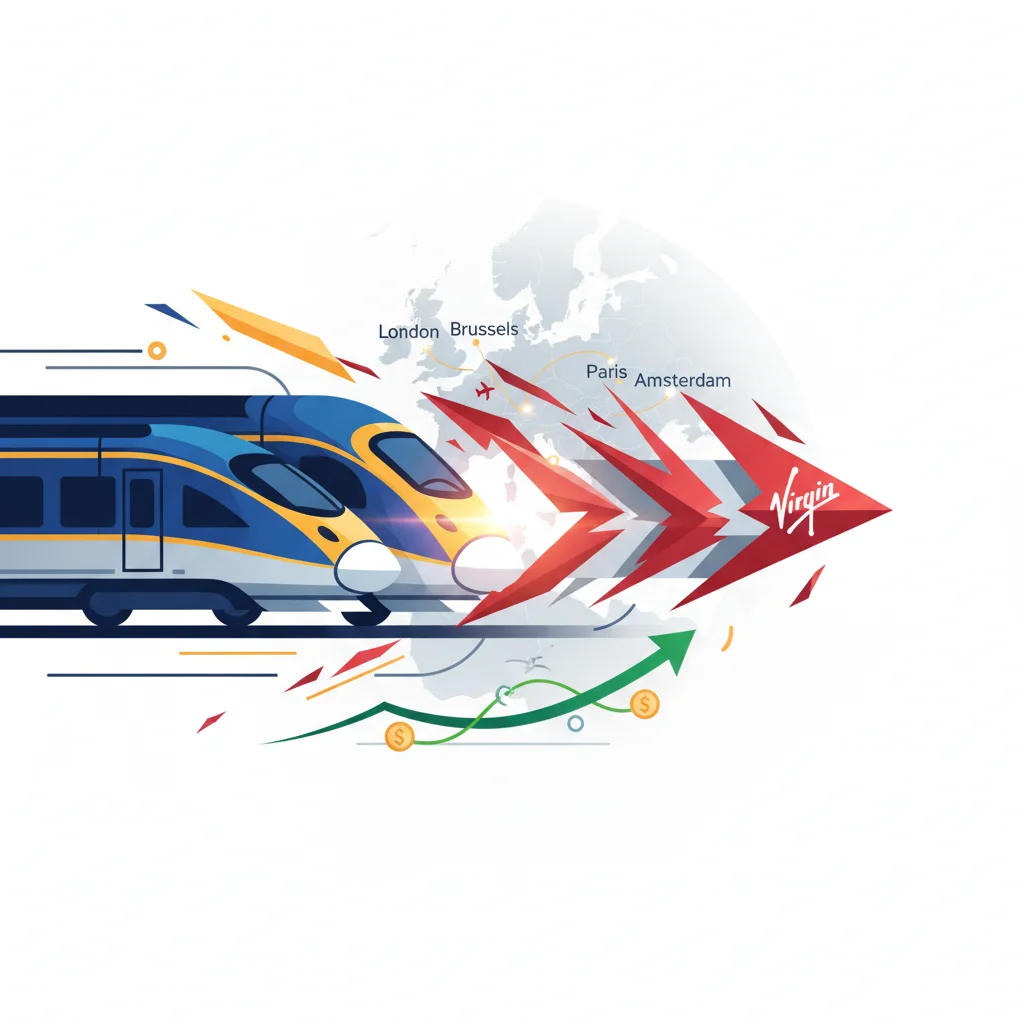
The Disruption Express: How Virgin’s Challenge to Eurostar Could Reshape European Travel and Investing
For nearly three decades, the journey from London to Paris, Brussels, or Amsterdam by rail has been synonymous with one name: Eurostar. A titan of transport, it has enjoyed a near-monopoly on the cross-Channel passenger rail market, a position solidified by immense operational complexity and staggering financial barriers to entry. But the landscape of European travel is on the verge of a seismic shift. In a move that has sent ripples through the transport and finance sectors, Sir Richard Branson’s Virgin Group is gearing up to go head-to-head with the incumbent, signaling the most significant challenge to Eurostar’s dominance since the Channel Tunnel opened.
Virgin Trains has officially won a bid to share a crucial rail depot, a foundational step in its plan to launch competing services through the iconic “Chunnel,” as reported by the BBC. This isn’t just about adding a new logo to the departure boards at St Pancras International; it’s a multi-billion-dollar gambit that could redefine pricing, service, and innovation in one of Europe’s most lucrative travel corridors. For investors, business leaders, and anyone interested in the economics of infrastructure and competition, this development is a masterclass in market disruption unfolding in real time.
Understanding the Fortress: The Economics of Eurostar’s Dominance
To appreciate the magnitude of Virgin’s challenge, one must first understand the fortress they are attempting to breach. Eurostar’s position isn’t an accident; it’s the result of a “natural monopoly” fortified by immense capital costs, regulatory hurdles, and operational intricacies. The initial investing required to launch a cross-Channel service runs into the billions, covering everything from custom-built rolling stock to navigating a labyrinth of international safety standards.
The trains themselves are not off-the-shelf models. They must comply with the stringent and unique safety regulations of the Channel Tunnel, including the ability to be split in the event of a fire and meet specific length and power requirements. This bespoke engineering dramatically increases costs. Furthermore, securing access—or “paths”—on the high-speed lines in the UK (HS1), France (SNCF Réseau), and Belgium (Infrabel) is a complex negotiation process. These paths are the lifeblood of any rail service, dictating departure and arrival times, and competition for prime slots is fierce. For years, these barriers have been sufficient to deter all but the most determined potential competitors, allowing Eurostar to command the market. According to Getlink, the Channel Tunnel operator, Eurostar carried over 18.6 million passengers in 2023, showcasing the scale of the market Virgin aims to tap into.
Beyond the Headlines: Decoding the New US Sanctions on Russia's Oil and the Global Economic Fallout
The Virgin Playbook: A Calculated Gamble on Brand and Competition
Virgin’s strategy is likely to be a familiar one: leveraging its powerful brand, renowned for a focus on customer experience, to disrupt an established market. The playbook was written with Virgin Atlantic’s challenge to British Airways and has been replicated across industries from media to telecommunications. The core premise is that a market dominated by a single player often leads to complacency in service and pricing. By introducing choice, Virgin can capture a significant slice of the market, even if it doesn’t become the dominant player overnight.
The financial calculus is daunting. This venture will require a monumental capital raise, likely involving a consortium of private equity, sovereign wealth funds, and major banking institutions specializing in infrastructure finance. The performance of related companies on the stock market, such as train manufacturers like Alstom and Siemens or the tunnel operator Getlink, will be watched closely by analysts. A successful launch by Virgin could increase revenue for suppliers and Getlink but would simultaneously place immense pressure on Eurostar’s profitability.
Below is a breakdown of the key challenges Virgin faces compared to the established position of Eurostar.
| Challenge Area | Eurostar (Incumbent) | Virgin Trains (Challenger) |
|---|---|---|
| Capital Investment | Existing fleet, infrastructure, and brand equity built over 30 years. | Requires billions in new investing for rolling stock, staff, and marketing. |
| Regulatory Approval | Established compliance with all UK and EU rail and tunnel authorities. | Must undergo a rigorous and lengthy certification process for new trains and operations. |
| Track Access & Timetabling | Holds many of the most desirable “paths” and station slots. | Must negotiate for limited available slots, potentially at less optimal times initially. |
| Brand Recognition | Synonymous with cross-Channel rail travel. High brand trust. | Strong general brand, but must build specific trust for this international service. |
| Market Pricing | Sets the benchmark for pricing, often with a premium model. | Can compete on price to gain market share, but risks a price war that erodes margins. |
The Broader Economic Impact: More Than Just Cheaper Tickets
The introduction of a serious competitor on the cross-Channel route promises benefits that extend far beyond consumer choice. From an economics perspective, increased competition can act as a powerful stimulus.
Firstly, it will likely lead to a downward pressure on fares, making European travel more accessible for both leisure and business. This, in turn, can boost the tourism and hospitality sectors in London, Paris, and other connected cities. Secondly, enhanced connectivity is a proven driver of economic growth, fostering closer business ties and facilitating trade in services. A more competitive and robust rail link makes the UK a more attractive hub for European business operations, a crucial factor in the post-Brexit economy.
For those involved in investing, this creates a new dynamic. Infrastructure funds will see this as a test case for liberalizing other major European transport routes. The success or failure of Virgin’s venture will provide invaluable data on the true risks and rewards of challenging an entrenched monopoly in a capital-intensive industry. The entire supply chain, from train manufacturing and maintenance to onboard catering and digital services, stands to benefit from the presence of a second major customer.
The Third Way for Pensions: Are Collective Schemes the Future of UK Retirement?
A Familiar Story: Why Others Have Tried and Failed
It is crucial to view Virgin’s ambitions with a dose of historical context. They are not the first to dream of competing with Eurostar. Most notably, Germany’s national rail operator, Deutsche Bahn (DB), spent years planning a direct service from London to Frankfurt and Amsterdam. In 2013, DB even ran a demonstration ICE train through the tunnel to signal its intent. However, the project was ultimately shelved due to a combination of high costs, regulatory delays, and challenges in procuring trains that met the tunnel’s unique specifications (source). DB’s experience serves as a cautionary tale, highlighting that ambition and a world-class reputation are not always enough to conquer the Channel Tunnel’s complexities.
What might be different this time? The political and regulatory climate has slowly shifted towards encouraging more competition on Europe’s rails. Furthermore, advancements in train manufacturing may offer more options than were available to DB a decade ago. Virgin’s entry is a bet that the timing is finally right.
The Future of the Chunnel: All Aboard for a New Era
Virgin’s move to challenge Eurostar is more than a business story; it’s the beginning of a new chapter for European connectivity. While the path ahead is steep and fraught with financial and logistical challenges, the potential rewards are immense. For consumers, it heralds an era of greater choice and potentially lower fares. For the broader economy, it represents a powerful injection of competition and investment into a vital infrastructure artery.
Investors and market analysts will be watching with keen interest. This is a high-stakes game of strategy, finance, and execution that will test the limits of the Virgin brand and the resilience of Eurostar’s long-held monopoly. The journey has just begun, but one thing is certain: the cross-Channel rail market is about to become one of the most exciting and closely-watched competitive arenas in the world.
The success of this venture could even set a precedent for how future infrastructure projects are approached, perhaps integrating novel funding mechanisms or leveraging emerging technologies like blockchain for supply chain transparency and secure ticketing systems. While such applications are still on the horizon, the disruptive spirit driving this challenge is what pushes industries forward. The departure board is set, and the race for the future of European rail travel is on.


